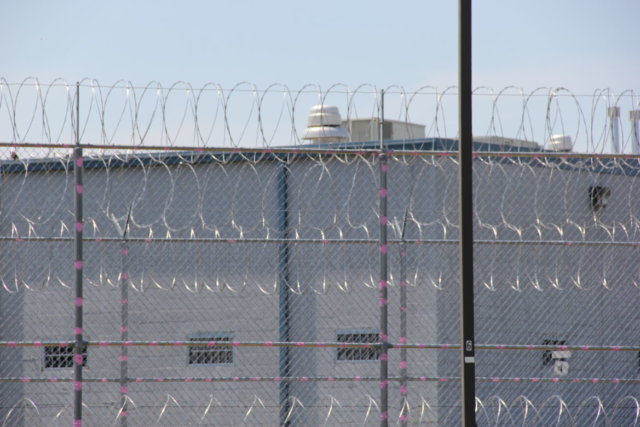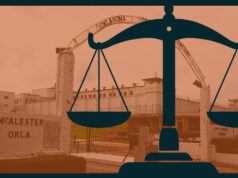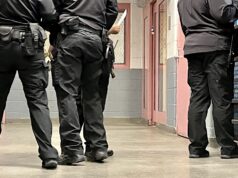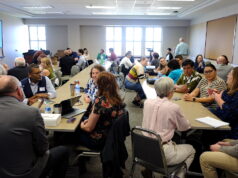

(Editor’s note: This story was authored by Ben Botkin of Oklahoma Watch and appears here in accordance with the non-profit journalism organization’s republishing terms.)
The number of people sentenced to Oklahoma prisons in 2017 fell slightly, but the state remains second in the nation in overall incarceration and could be ranked first by the end of this year.
Oklahoma Department of Corrections data shows that on the last working day of 2017, a total of 28,153 inmates were in state prisons, halfway houses or in jails awaiting transfer to prisons. That was a less than 1 percent decline from the end of 2016.
The relatively small change occurred in the face of nearly a half year of criminal justice reforms approved by voters in November 2016 and some measures passed in the Legislature in 2017.
Advocates of changes in laws to relieve overcrowded prisons have said the passage of State Questions 780 and 781, which took effect July 1, are not enough to turn the tide of heavy incarceration in the state and more reforms are needed.
Oklahoma could end up leading the nation in incarceration rates because Louisiana, which has the highest rate, passed new laws last year that are expected to decrease the number and rate of people imprisoned.
In a recent annual U.S. Bureau of Justice Statistics report, Oklahoma ranked first in female incarceration at the end of 2016, with 149 women sentenced to more than a year in prison per 100,000 female residents. The state was second in both male incarceration, with a rate of 1,207, and overall incarceration, with a rate of 673. That compared with Louisiana’s 760. The national per-capita rate was 450.
“Unfortunately, none of this is a surprise,” said Corrections Director Joe Allbaugh. He said he expects Oklahoma’s rate to become the highest because of Louisiana’s reforms and “the limited results of criminal justice reform in our state.”
The federal report said that from 2015 to 2016, Oklahoma’s number of inmates sentenced to at least a year in prison dropped by 5.8 percent, meaning 1,628 fewer sentenced inmates. The Corrections Department disputed the federal figures, saying the report left out inmates in jails awaiting transfer to prisons. The Bureau of Justice Statistics reports on its website that it does include such inmates.
The Corrections Department acknowledges Oklahoma’s national rankings, which derive from the Bureau of Justice Statistics’ data. In a recent interview, Allbaugh pointed especially to the state’s incarceration of males, who comprise 88 percent of the prison population.
“We’re number two in males right now, but we’re soon to claim the number-one spot in the male category,” Allbaugh said.
The reforms in Louisiana are expected to reduce that state’s prison population by 10 percent in the next decade. Reforms include lower minimum sentences and greater eligibility for parole. The impact has already been seen in Louisiana, with the early release of about 1,900 nonviolent offenders in November.
Kevin Armstrong, president of OK Cure, a Tulsa-based criminal justice reform advocacy group, suggested Oklahoma look to Louisiana as an example of how to reduce the prison population, in particular sentence reductions.
“I’m tired of being the worst in the nation in this area and we want to move past that,” he said.
In many ways, momentum has swung in that direction.
State Question 780, which passed with 58 percent of the vote in 2016, made simple possession of any drug and certain property crimes misdemeanors, with the goal of imprisoning fewer people. SQ 781, which won with 56 percent, is to use any savings from that reduction to fund mental-health and substance-abuse treatment programs. Many business, civic and government leaders have advocated for criminal justice changes, saying too many non-violent offenders are behind bars and both the human and financial costs to the state are onerous.
It may be too early to assess the ultimate impact of the state questions on incarceration. But despite their passage, “(incarceration) growth is expected to continue, costing the state over $1.9 billion in the next 10 years unless further changes are made,” said a study by the Oklahoma Justice Reform Task Force, assembled by Gov. Mary Fallin.
Advocates for further changes in the system will be watching the upcoming legislative session. Last year, a slate of criminal justice reform bills largely failed to advance but are still in play, to be taken up when the Legislature convenes Feb. 5. Of the 12 bills that legislators considered, Fallin signed three into law. Eight bills failed to advance but remain alive.




















